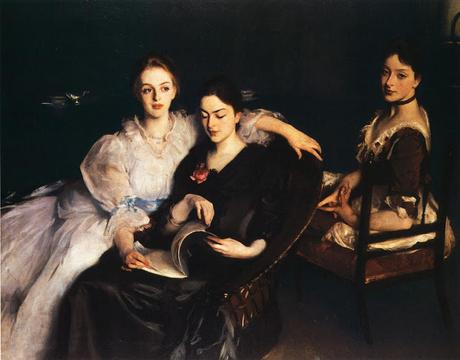
Figlio di genitori statunitensi, nato in Italia nel 1856, John Singer Sargent inizia il suo percorso artistico proprio all'accademia delle belle Arti di Firenze, sua città natale, per poi proseguire a Parigi, sotto l'irresistibile influenza degli impressionisti francesi. Seguono nuovi viaggi ricchi di ispirazione e fascino in tutta Europa, dall'Inghilterra alla Spagna, sinonimo della sua incessante voglia di crescita e sperimentazione. Attento all'estetica come anche alla psicologia umana ed essendo amante della lettura, attraverso l'osservazione bilaterale dei personaggi ebbe la capacità di circoscrivere la sua attività all'interno dei più importanti ambienti aristocratici europei ed americani dell'epoca, riscuotendo un enorme successo come ritrattista. La sua formazione a questo punto mondiale, era palesata dalle sue medesime parole: "Sono uno statunitense nato in Italia, educato in Francia, che parla inglese, sembro un tedesco e dipingo come uno spagnolo".
Il dipinto che osserviamo quest'oggi è ovviamente un ritratto, The Misses Vickers in cui il soggetto è composto dallo sfondo familiare di tre fanciulle, sorelle, ma molto diverse fra loro. Lo scenario, mostra una luce contrastante: la ragazza seduta di spalle che si volta verso il pittore, sembra essere una sorella maggiore, sembra avere maggiore consapevolezza e decisione rispetto alle altre due, pur conservando uno sguardo languido e molto femminile; intreccia le mani, ma in maniera composta, come per ostentare sicurezza. Anche il suo abito è assai più audace di quello delle altre sorelle, più scollato, ricco di pizzi e dalla tonalità più decisa. La fanciulla dai capelli rossi, con lo sguardo alto è la più delicata, una caratteristica che rispecchia probabilmente anche l'aspetto caratteriale della giovane. La perfezione con cui è stata dipinta, riesce quasi a far percepire un sorriso trattenuto, forse nella consapevolezza di essere immortalata sulla tela. La sua pelle, unitamente al vestito bianco, regalano al dipinto una luce diversa, mentre le sue braccia tentano di contornare la sorella vicina.Può essere che questa scena e anche le singole pose siano state premeditate dall'artista, ma in maniera molto naturale, così da far emergere le reali personalità delle ragazze. La sorella al centro, a mio avviso la più enigmatica dell'opera, abbassa la sguardo, non permettendo al pittore di catturarlo. Apparentemente per leggerezza. La stessa con cui sembra sfogliare il giornale che ha fra le mani. Ma in realtà la fanciulla non sembra molto interessata alla lettura. La sua è un'azione volta a celare la timidezza. Anche le sue labbra sono trattenute, ma non dalla risata, sembra piuttosto che non voglia far trasparire alcuna emozione, se non la tranquillità, che le serve a confermare un'ideale padronanza emotiva. Ciò che però è l'autore dell'opera è riuscito perfettamente a rendere è la condizione di calma e serenità domestica, requisito fondamentale che chiarisce anche il perché le famiglie amassero tanto i suoi ritratti.
Son of american parents, born in Italy in 1856, John Singer Sargent began his own artistic career at the Florence Academy of Fin, in his hometown, and then go to Paris, under the irresistible influence of French impressionists. Following new trips rich of charm and inspiration throughout Europe, from England to Spain, a synonym of his incessant desire of growth and experimentation. Sensitive to aesthetics as well as to human psychology and being a reading lover, through bilateral character observation, he had the ability to limit his activities in the most important European and American aristocratics of the time, enjoying great success as portraitist. His worldwide education was clearly evident from his own words: "I am an American born in Italy, educated in France, speaking English, I look like a German and I paint like a Spaniard."
The painting we see today is obviously a portrait, "The Misses Vickers" in which the subject is made from the family background of three girls, sisters, but very different.The scenario shows a contrasting light: the girl sitting behind that turns to the painter, seems to be a major sister, she seems to have increased awareness and decision than the other two, while maintaining a languid and very feminine look; she intertwin her hands, but in a compound way like to flaunt safety. Even her dress is much more daring than the other sisters, most low-cut, full of lace and from a more definite tone.The red-haired girl, looking up is the most delicate, a feature that probably also reflects the character of the young. The perfection with which she is painted, almost unable to perceive a restrained smile, perhaps in the knowledge of being immortalized on canvas. Her skin, together with the white dress, give the painting a different light, as her arms trying to surround the nearby sister.It may be that this scene and also the individual poses have been premeditated by the artist, but in a very natural way, so as to bring out the real personality of the girls.The sister in the middle, I think the most enigmatic of the work, lowering her gaze, not allowing the painter to capture it. Apparently for lightness. The same with which she seems to read newspaper in her hands. But in reality the girl does not seem very interested in reading. It seems an action to conceal her shyness. Even her lips are retained, but not by the laughter, it seems rather than to forbid any emotion, if not peace, that serves to confirm an ideal emotional mastery.But what is the author has perfectly managed is to make is the peace and domestic quiet condition, which also clarifies the fundamental requirement because families loved both his portraits.
